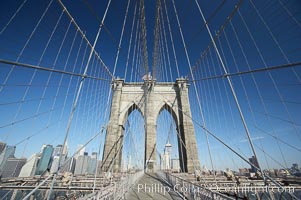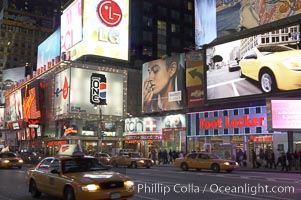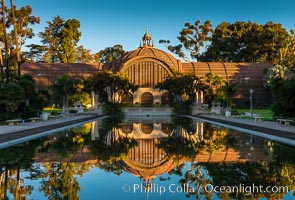
The Botanical Building in Balboa Park, San Diego. The Botanical Building, at 250 feet long by 75 feet wide and 60 feet tall, was the largest wood lath structure in the world when it was built in 1915 for the Panama-California Exposition. The Botanical Building, located on the Prado, west of the Museum of Art, contains about 2,100 permanent tropical plants along with changing seasonal flowers. The Lily Pond, just south of the Botanical Building, is an eloquent example of the use of reflecting pools to enhance architecture. The 193' by 43' foot pond and smaller companion pool were originally referred to as Las Lagunas de las Flores (The Lakes of the Flowers) and were designed as aquatic gardens. The pools contain exotic water lilies and lotus which bloom spring through fall.
Location: Balboa Park, San Diego, California
Image ID: 28823
Location: Balboa Park, San Diego, California
Image ID: 28823
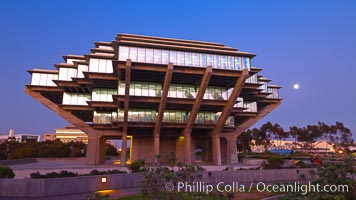
UCSD Library glows at sunset (Geisel Library, UCSD Central Library).
Location: University of California, San Diego
Image ID: 26908
Location: University of California, San Diego
Image ID: 26908
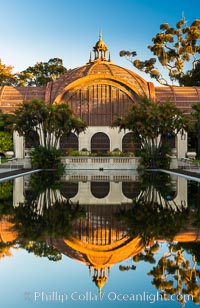
The Botanical Building in Balboa Park, San Diego. The Botanical Building, at 250 feet long by 75 feet wide and 60 feet tall, was the largest wood lath structure in the world when it was built in 1915 for the Panama-California Exposition. The Botanical Building, located on the Prado, west of the Museum of Art, contains about 2,100 permanent tropical plants along with changing seasonal flowers. The Lily Pond, just south of the Botanical Building, is an eloquent example of the use of reflecting pools to enhance architecture. The 193' by 43' foot pond and smaller companion pool were originally referred to as Las Lagunas de las Flores (The Lakes of the Flowers) and were designed as aquatic gardens. The pools contain exotic water lilies and lotus which bloom spring through fall.
Location: Balboa Park, San Diego, California
Image ID: 28822
Location: Balboa Park, San Diego, California
Image ID: 28822
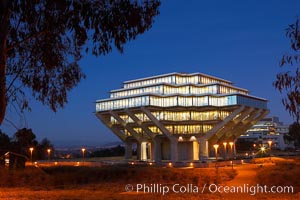
UCSD Library glows at sunset (Geisel Library, UCSD Central Library).
Location: University of California, San Diego, La Jolla
Image ID: 14780
Location: University of California, San Diego, La Jolla
Image ID: 14780
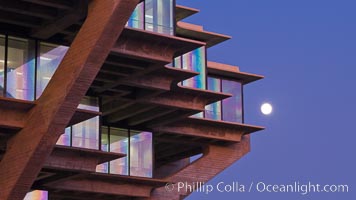
UCSD Library glows at sunset (Geisel Library, UCSD Central Library).
Location: University of California, San Diego
Image ID: 26909
Location: University of California, San Diego
Image ID: 26909
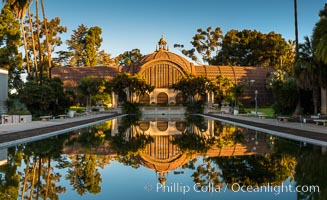
The Botanical Building in Balboa Park, San Diego. The Botanical Building, at 250 feet long by 75 feet wide and 60 feet tall, was the largest wood lath structure in the world when it was built in 1915 for the Panama-California Exposition. The Botanical Building, located on the Prado, west of the Museum of Art, contains about 2,100 permanent tropical plants along with changing seasonal flowers. The Lily Pond, just south of the Botanical Building, is an eloquent example of the use of reflecting pools to enhance architecture. The 193' by 43' foot pond and smaller companion pool were originally referred to as Las Lagunas de las Flores (The Lakes of the Flowers) and were designed as aquatic gardens. The pools contain exotic water lilies and lotus which bloom spring through fall.
Location: Balboa Park, San Diego, California
Image ID: 28824
Panorama dimensions: 6045 x 9876
Location: Balboa Park, San Diego, California
Image ID: 28824
Panorama dimensions: 6045 x 9876
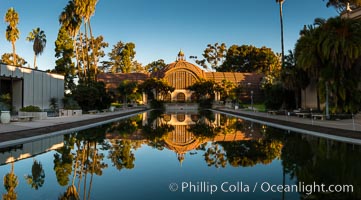
The Botanical Building in Balboa Park, San Diego. The Botanical Building, at 250 feet long by 75 feet wide and 60 feet tall, was the largest wood lath structure in the world when it was built in 1915 for the Panama-California Exposition. The Botanical Building, located on the Prado, west of the Museum of Art, contains about 2,100 permanent tropical plants along with changing seasonal flowers. The Lily Pond, just south of the Botanical Building, is an eloquent example of the use of reflecting pools to enhance architecture. The 193' by 43' foot pond and smaller companion pool were originally referred to as Las Lagunas de las Flores (The Lakes of the Flowers) and were designed as aquatic gardens. The pools contain exotic water lilies and lotus which bloom spring through fall.
Location: Balboa Park, San Diego, California
Image ID: 28825
Panorama dimensions: 6838 x 12347
Location: Balboa Park, San Diego, California
Image ID: 28825
Panorama dimensions: 6838 x 12347
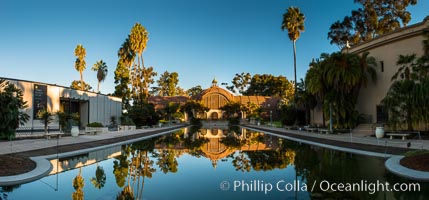
The Botanical Building in Balboa Park, San Diego. The Botanical Building, at 250 feet long by 75 feet wide and 60 feet tall, was the largest wood lath structure in the world when it was built in 1915 for the Panama-California Exposition. The Botanical Building, located on the Prado, west of the Museum of Art, contains about 2,100 permanent tropical plants along with changing seasonal flowers. The Lily Pond, just south of the Botanical Building, is an eloquent example of the use of reflecting pools to enhance architecture. The 193' by 43' foot pond and smaller companion pool were originally referred to as Las Lagunas de las Flores (The Lakes of the Flowers) and were designed as aquatic gardens. The pools contain exotic water lilies and lotus which bloom spring through fall.
Location: Balboa Park, San Diego, California
Image ID: 28826
Panorama dimensions: 5475 x 11746
Location: Balboa Park, San Diego, California
Image ID: 28826
Panorama dimensions: 5475 x 11746
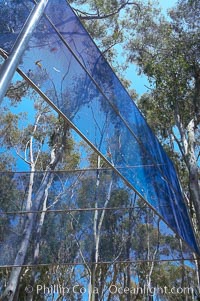
The Giraffe Traps, or what is officially known as Two Running Violet V Forms, was the second piece in the Stuart Collection at University of California San Diego (UCSD). Commissioned in 1983 and produced by Robert Irwin, the odd fence resides in the eucalyptus grove between Mandeville Auditorium and Central Library.
Location: University of California, San Diego, La Jolla
Image ID: 12842
Location: University of California, San Diego, La Jolla
Image ID: 12842
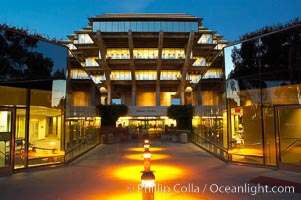
UCSD Library glows at sunset (Geisel Library, UCSD Central Library).
Location: University of California, San Diego, La Jolla
Image ID: 14777
Location: University of California, San Diego, La Jolla
Image ID: 14777
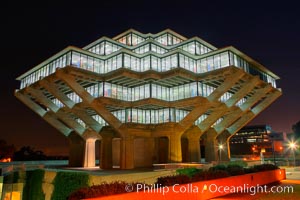
UCSD Library glows with light in this night time exposure (Geisel Library, UCSD Central Library).
Location: University of California, San Diego, La Jolla
Image ID: 20142
Location: University of California, San Diego, La Jolla
Image ID: 20142
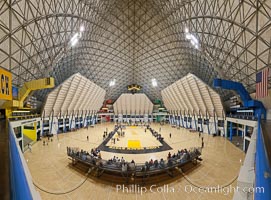
Walter Pyramid, Cal State Long Beach. The home of Long Beach State basketball and volleyball for over 15 years, the Walter Pyramid has become a nationally recognized icon for the university and the city of Long Beach. Designed by Long Beach architect Don Gibbs and built by the Nielson Construction Company of San Diego, The Walter Pyramid cost approximately $22 million.
Location: Long Beach, California
Image ID: 26786
Panorama dimensions: 9657 x 13092
Location: Long Beach, California
Image ID: 26786
Panorama dimensions: 9657 x 13092
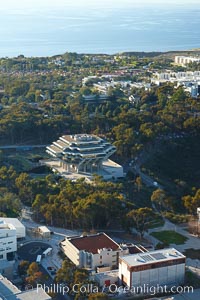
University of California San Diego, with Geisel Library (UCSD Main library) seen amid a grove of eucalyptus trees, with the Pacific Ocean in the distance.
Location: La Jolla, California
Image ID: 22414
Location: La Jolla, California
Image ID: 22414
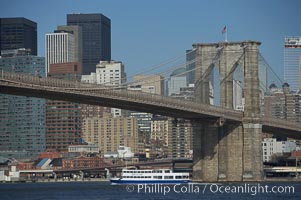
Brooklyn Bridge viewed from Brooklyn. Lower Manhattan visible behind the Bridge.
Location: Brooklyn Bridge, New York City
Image ID: 11064
Location: Brooklyn Bridge, New York City
Image ID: 11064
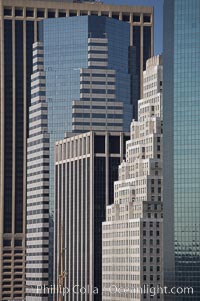
Lower Manhattan skyline viewed from the Brooklyn Bridge.
Location: Manhattan, New York City
Image ID: 11090
Location: Manhattan, New York City
Image ID: 11090
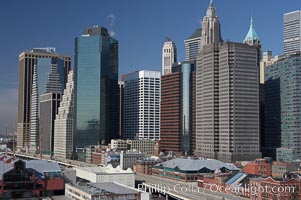
Lower Manhattan skyline viewed from the Brooklyn Bridge.
Location: Manhattan, New York City
Image ID: 11091
Location: Manhattan, New York City
Image ID: 11091
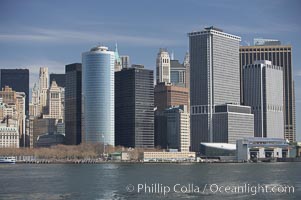
Lower Manhattan skyline viewed from the Brooklyn Bridge.
Location: Manhattan, New York City
Image ID: 11096
Location: Manhattan, New York City
Image ID: 11096
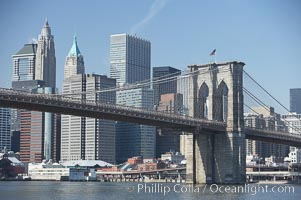
Lower Manhattan and Brooklyn Bridge, viewed from the East River.
Location: Manhattan, New York City
Image ID: 11118
Location: Manhattan, New York City
Image ID: 11118
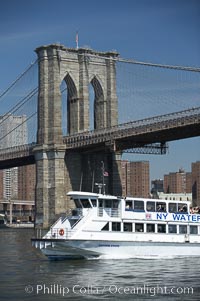
Lower Manhattan and the Brooklyn Bridge viewed from the East River.
Location: Manhattan, New York City
Image ID: 11122
Location: Manhattan, New York City
Image ID: 11122
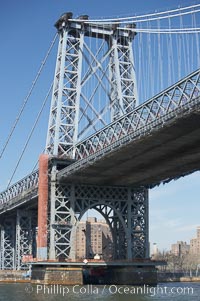
The Williamsburg Bridge viewed from the East River. The Williamsburg Bridge is a suspension bridge in New York City across the East River connecting the Lower East Side of Manhattan at Delancey Street with the Williamsburg neighborhood of Brooklyn on Long Island at Broadway near the Brooklyn-Queens Expressway.
Location: Manhattan, New York City
Image ID: 11124
Location: Manhattan, New York City
Image ID: 11124
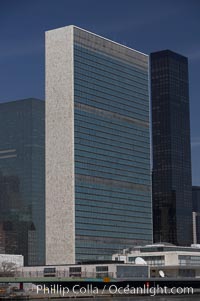
The United Nations Building rises above the New York skyline as viewed from the East River.
Location: Manhattan, New York City
Image ID: 11131
Location: Manhattan, New York City
Image ID: 11131
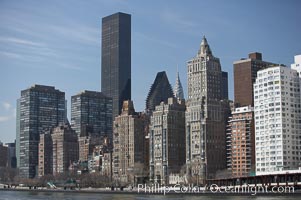
New York Citys Upper East Side, viewed from the East River.
Location: Manhattan, New York City
Image ID: 11141
Location: Manhattan, New York City
Image ID: 11141
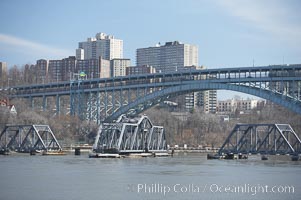
Spuyten Duyvil Swing Bridge (foreground) and Henry Hudson Bridge (background). The Spuyten Duyvil Bridge is a swing bridge that carries Amtrak's Empire Corridor line across the Spuyten Duyvil Creek between Manhattan and the Bronx, in New York City. The bridge is located at the point where Spuyten Duyvil Creek and the Hudson River meet.
Location: Manhattan, New York City
Image ID: 11149
Location: Manhattan, New York City
Image ID: 11149
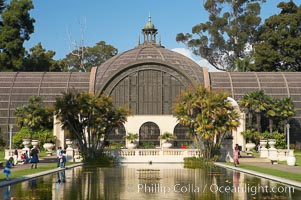
The Botanical Building in Balboa Park, San Diego. The Botanical Building, at 250 feet long by 75 feet wide and 60 feet tall, was the largest wood lath structure in the world when it was built in 1915 for the Panama-California Exposition. The Botanical Building, located on the Prado, west of the Museum of Art, contains about 2,100 permanent tropical plants along with changing seasonal flowers. The Lily Pond, just south of the Botanical Building, is an eloquent example of the use of reflecting pools to enhance architecture. The 193 by 43 foot pond and smaller companion pool were originally referred to as Las Lagunas de las Flores (The Lakes of the Flowers) and were designed as aquatic gardens. The pools contain exotic water lilies and lotus which bloom spring through fall. Balboa Park, San Diego.
Location: Balboa Park, San Diego, California
Image ID: 14578
Location: Balboa Park, San Diego, California
Image ID: 14578
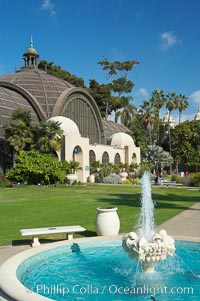
The Botanical Building in Balboa Park, San Diego. The Botanical Building, at 250 feet long by 75 feet wide and 60 feet tall, was the largest wood lath structure in the world when it was built in 1915 for the Panama-California Exposition. The Botanical Building, located on the Prado, west of the Museum of Art, contains about 2,100 permanent tropical plants along with changing seasonal flowers. The Lily Pond, just south of the Botanical Building, is an eloquent example of the use of reflecting pools to enhance architecture. The 193 by 43 foot pond and smaller companion pool were originally referred to as Las Lagunas de las Flores (The Lakes of the Flowers) and were designed as aquatic gardens. The pools contain exotic water lilies and lotus which bloom spring through fall. Balboa Park, San Diego.
Location: Balboa Park, San Diego, California
Image ID: 14582
Location: Balboa Park, San Diego, California
Image ID: 14582
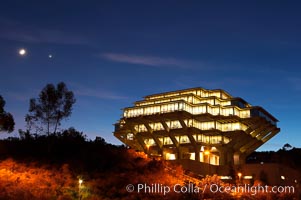
UCSD Library glows at sunset (Geisel Library, UCSD Central Library).
Location: University of California, San Diego, La Jolla
Image ID: 14784
Location: University of California, San Diego, La Jolla
Image ID: 14784
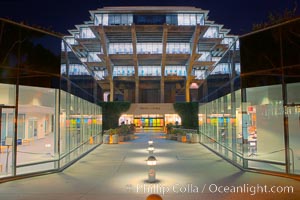
UCSD Library glows with light in this night time exposure (Geisel Library, UCSD Central Library).
Location: University of California, San Diego, La Jolla
Image ID: 20143
Location: University of California, San Diego, La Jolla
Image ID: 20143
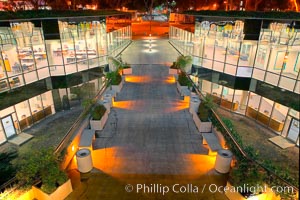
UCSD Library glows with light in this night time exposure (Geisel Library, UCSD Central Library).
Location: University of California, San Diego, La Jolla
Image ID: 20145
Location: University of California, San Diego, La Jolla
Image ID: 20145
